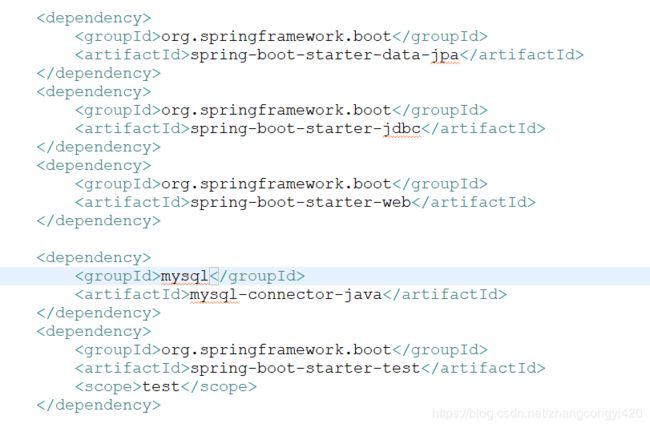springboot整合jpa
JPA是什么
JPA(java persistence api),它并不是一个框架,而是一组规范。我觉得对于任何一个开发人员来说,理解“规范”这个词应该不在话下。其中,Hibernate就实现了这个规范,而且呢是相当成功的(其实TopLink和OpenJPA也都实现了JPA规范,不过它们被Hinernate的光环笼罩了)。所以呢,当我们说到JPA的时候,好多人首先想到的就是Hibernate。
其实通俗来讲,我们可以认为在jpa的这个规范下,框架使用了这个规范对和数据库的交互做了一些底层的封装,比如我们的sql语句,怎么从数据库查出我们需要的数据呢?其实很多框架都可以做这个事情,我们熟悉的mybatis,那个熟悉的组件,sqlSessionFactory都记得吧,无非就是建立了一个通道,把我们在程序中写的按照框架的规范的sql语句转化成数据库引擎可以解析的sql,这样解释应该很好懂了。
所以大家不要为框架的外表迷惑了,翻开框架底层源码,大小差不多。
下面我们来说是springboot整合jpa的过程,其实整合框架并不难,主要是springboot的版本升级太快,版本的问题带来的就是组件之间的兼容性问题,2.x之后和2.x之前的整合多少有些不太相似的地方,就导致整合时候各种奇葩的问题,后面会为大家列举出来。
1、首先配置pom依赖文件,
org.springframework.boot
spring-boot-starter-parent
2.0.1.RELEASE
UTF-8
UTF-8
1.8
3.0.10.RELEASE
2.1.1
3.0.4.RELEASE
org.springframework.boot
spring-boot-starter-data-jpa
org.springframework.boot
spring-boot-starter-jdbc
org.springframework.boot
spring-boot-starter-web
mysql
mysql-connector-java
org.springframework.boot
spring-boot-starter-test
test
org.springframework.boot
spring-boot-starter-thymeleaf
org.thymeleaf
thymeleaf
${thymeleaf.version}
org.thymeleaf
thymeleaf-spring4
3.0.2.RELEASE
org.springframework.boot
spring-boot-starter-security
org.thymeleaf.extras
thymeleaf-extras-springsecurity4
${thymeleaf-extras-springsecurity4.version}
org.springframework.session
spring-session
1.3.4.RELEASE
org.springframework.boot
spring-boot-starter-data-redis
2、接下来是配置文件,这里我使用的是application.properties,根据个人习惯,也可以使用yml,这里我在整合的使用需要使用到spring-session和spring-security的东西,因此后面的spring-session的配置大家可以酌情使用,可以不配置,
server.port=8087
# Mysql
spring.datasource.driver-class-name=com.mysql.jdbc.Driver
spring.datasource.jdbc-url=jdbc:mysql://localhost:3306/xunwu?useUnicode=true&characterEncoding=utf-8&useSSL=false
spring.datasource.username=root
spring.datasource.password=root
#jpa
spring.jpa.hibernate.ddl-auto=validate
spring.jpa.show-sql=true
spring.jpa.hibernate.naming.physical-strategy=org.springframework.boot.orm.jpa.hibernate.SpringPhysicalNamingStrategy
logging.level.org.hibernate.SQL=debug
# session会话存储类型
spring.session.store-type=none
#spring.redis.database=0
#spring.redis.host=127.0.0.1
#spring.redis.port=6379
#spring.redis.pool.min-idle=1
#spring.redis.timeout=3000
# 关闭HTTP基本验证
security.basic.enabled=false
3、这里为了使得项目结构显得更有层次感,我使用了配置bean的形式来管理数据源,也就是springboot比较流行的使用bean形式配置和数据库连接的操作,方便管理,这里我使用了一个jpaConfig的类,代码如下,
package com.congge.config;
import javax.persistence.EntityManagerFactory;
import javax.sql.DataSource;
//import org.springframework.boot.autoconfigure.jdbc.DataSourceBuilder;
import org.springframework.boot.context.properties.ConfigurationProperties;
import org.springframework.boot.jdbc.DataSourceBuilder;
import org.springframework.context.annotation.Bean;
import org.springframework.context.annotation.Configuration;
import org.springframework.data.jpa.repository.config.EnableJpaRepositories;
import org.springframework.orm.jpa.JpaTransactionManager;
import org.springframework.orm.jpa.LocalContainerEntityManagerFactoryBean;
import org.springframework.orm.jpa.vendor.HibernateJpaVendorAdapter;
import org.springframework.transaction.PlatformTransactionManager;
import org.springframework.transaction.annotation.EnableTransactionManagement;
/**
* congge
*/
@Configuration
@EnableJpaRepositories(basePackages = "com.congge.repository")
@EnableTransactionManagement
public class JPAConfig {
//加载数据库连接信息
@Bean
@ConfigurationProperties(prefix = "spring.datasource")
public DataSource dataSource() {
return DataSourceBuilder.create().build();
}
//配置jpa连接工厂和实体映射
@Bean
public LocalContainerEntityManagerFactoryBean entityManagerFactory() {
HibernateJpaVendorAdapter japVendor = new HibernateJpaVendorAdapter();
japVendor.setGenerateDdl(false);
LocalContainerEntityManagerFactoryBean entityManagerFactory = new LocalContainerEntityManagerFactoryBean();
entityManagerFactory.setDataSource(dataSource());
entityManagerFactory.setJpaVendorAdapter(japVendor);
entityManagerFactory.setPackagesToScan("com.congge.entity");
return entityManagerFactory;
}
//事务管理器
@Bean
public PlatformTransactionManager transactionManager(EntityManagerFactory entityManagerFactory) {
JpaTransactionManager transactionManager = new JpaTransactionManager();
transactionManager.setEntityManagerFactory(entityManagerFactory);
return transactionManager;
}
}
这里面有几个坑,有的同学在整合的时候,由于使用的是2.x之前的版本,这个配置类不要也可以,甚至不用@EnableJpaRepositories(basePackages = “com.congge.repository”) 这个注解都没问题,但我试过,项目怎么都起不来,报错的信息大概就是认为repository 也被纳入到spring框架作为一个bean管理,我这里使用的是2.0.1的版本,为了避免这个坑,就加上了;
4、上面使用了spring-session和spring-security的组件,我在整合启动的时候,发现怎么都不生效,也就是访问自己接口的时候,一直会调到需要验证的页面,找了很多资料,发现配置文件中仅仅有这个配置,根本不生效,也是2.x的版本和之前的版本用法不一致的原因导致,所以加了一个配置类,
security.basic.enabled=false
package com.congge.config;
import org.springframework.context.annotation.Configuration;
import org.springframework.security.config.annotation.web.builders.HttpSecurity;
import org.springframework.security.config.annotation.web.configuration.EnableWebSecurity;
import org.springframework.security.config.annotation.web.configuration.WebSecurityConfigurerAdapter;
/**
* http验证配置类
* @author asus
*
*/
@Configuration
@EnableWebSecurity
public class SecurityConfig extends WebSecurityConfigurerAdapter{
@Override
protected void configure(HttpSecurity http) throws Exception {
http.authorizeRequests().anyRequest().permitAll().and().logout().permitAll();
}
}
下面我们看看具体的业务代码,为了测试方便,我已经提前建好了测试的库和一张user表,

User实体类,
package com.congge.entity;
import java.util.Date;
import javax.persistence.Column;
import javax.persistence.Entity;
import javax.persistence.GeneratedValue;
import javax.persistence.GenerationType;
import javax.persistence.Id;
import javax.persistence.Table;
/**
* congge
*/
@Entity
@Table(name = "user")
public class User{
@Id
@GeneratedValue(strategy = GenerationType.IDENTITY)
private Long id;
private String name;
private String password;
private String email;
@Column(name = "phone_number")
private String phoneNumber;
private int status;
@Column(name = "create_time")
private Date createTime;
@Column(name = "last_login_time")
private Date lastLoginTime;
@Column(name = "last_update_time")
private Date lastUpdateTime;
private String avatar;
public Long getId() {
return id;
}
public void setId(Long id) {
this.id = id;
}
public String getName() {
return name;
}
public void setName(String name) {
this.name = name;
}
public String getPassword() {
return password;
}
public void setPassword(String password) {
this.password = password;
}
public String getEmail() {
return email;
}
public void setEmail(String email) {
this.email = email;
}
public String getPhoneNumber() {
return phoneNumber;
}
public void setPhoneNumber(String phoneNumber) {
this.phoneNumber = phoneNumber;
}
public int getStatus() {
return status;
}
public void setStatus(int status) {
this.status = status;
}
public Date getCreateTime() {
return createTime;
}
public void setCreateTime(Date createTime) {
this.createTime = createTime;
}
public Date getLastLoginTime() {
return lastLoginTime;
}
public void setLastLoginTime(Date lastLoginTime) {
this.lastLoginTime = lastLoginTime;
}
public Date getLastUpdateTime() {
return lastUpdateTime;
}
public void setLastUpdateTime(Date lastUpdateTime) {
this.lastUpdateTime = lastUpdateTime;
}
public String getAvatar() {
return avatar;
}
public void setAvatar(String avatar) {
this.avatar = avatar;
}
}
UserRepository,
package com.congge.repository;
import org.springframework.data.repository.CrudRepository;
import com.congge.entity.User;
/**
* congge
*/
public interface UserRepository extends CrudRepository {
User findByName(String userName);
User findUserByPhoneNumber(String telephone);
}
接口和实现类,
UserService:
package com.congge.service;
import com.congge.entity.User;
public interface UserService {
User findByName(String userName);
User findUserByPhoneNumber(String telephone);
}
UserServiceImpl:
package com.congge.service.impl;
import org.springframework.beans.factory.annotation.Autowired;
import org.springframework.stereotype.Service;
import com.congge.entity.User;
import com.congge.repository.UserRepository;
import com.congge.service.UserService;
@Service("userService")
public class UserServiceImpl implements UserService{
@Autowired
private UserRepository userRepository;
@Override
public User findByName(String userName) {
return userRepository.findByName(userName);
}
@Override
public User findUserByPhoneNumber(String telephone) {
return null;
}
}
最后写一个测试的UserController,
package com.congge.controller;
import org.springframework.beans.factory.annotation.Autowired;
import org.springframework.stereotype.Controller;
import org.springframework.web.bind.annotation.RequestMapping;
import org.springframework.web.bind.annotation.ResponseBody;
import com.congge.entity.User;
import com.congge.service.impl.UserServiceImpl;
@Controller
public class UserController {
@Autowired
private UserServiceImpl userService;
@RequestMapping("/getUserByName")
@ResponseBody
public User getUserByName(String name){
return userService.findByName(name);
}
}
main函数:
package com.congge;
import org.springframework.boot.SpringApplication;
import org.springframework.boot.autoconfigure.SpringBootApplication;
import org.springframework.boot.autoconfigure.jdbc.DataSourceAutoConfiguration;
@SpringBootApplication(exclude={DataSourceAutoConfiguration.class})
public class App {
public static void main(String[] args) {
SpringApplication.run(App.class, args);
}
}
运行main函数,我们在浏览器上输入:http://localhost:8087/getUserByName?name=waliwali
可以看到已经成功获取到数据库数据,说明我们的框架整合成功,需要整合的伙伴们可以提供下参考,最后感谢大家观看!!


